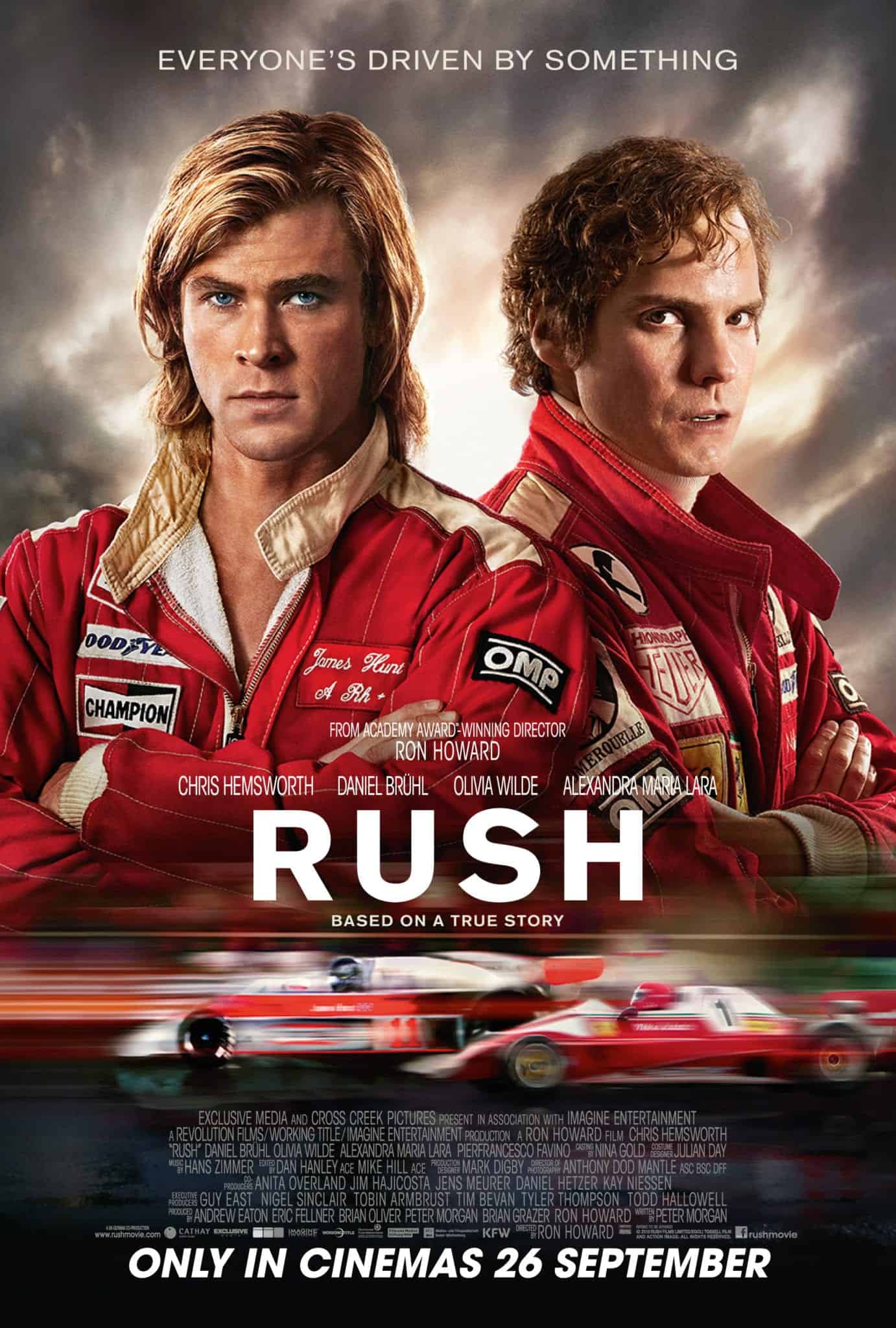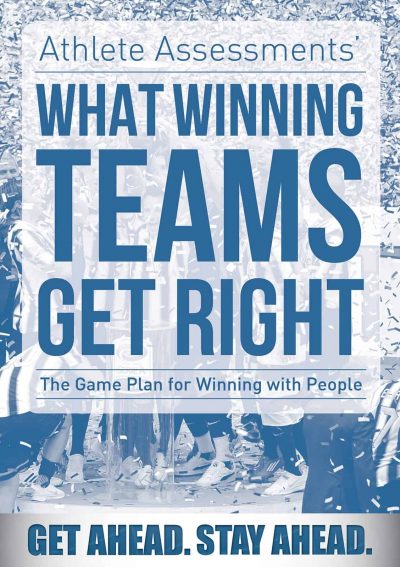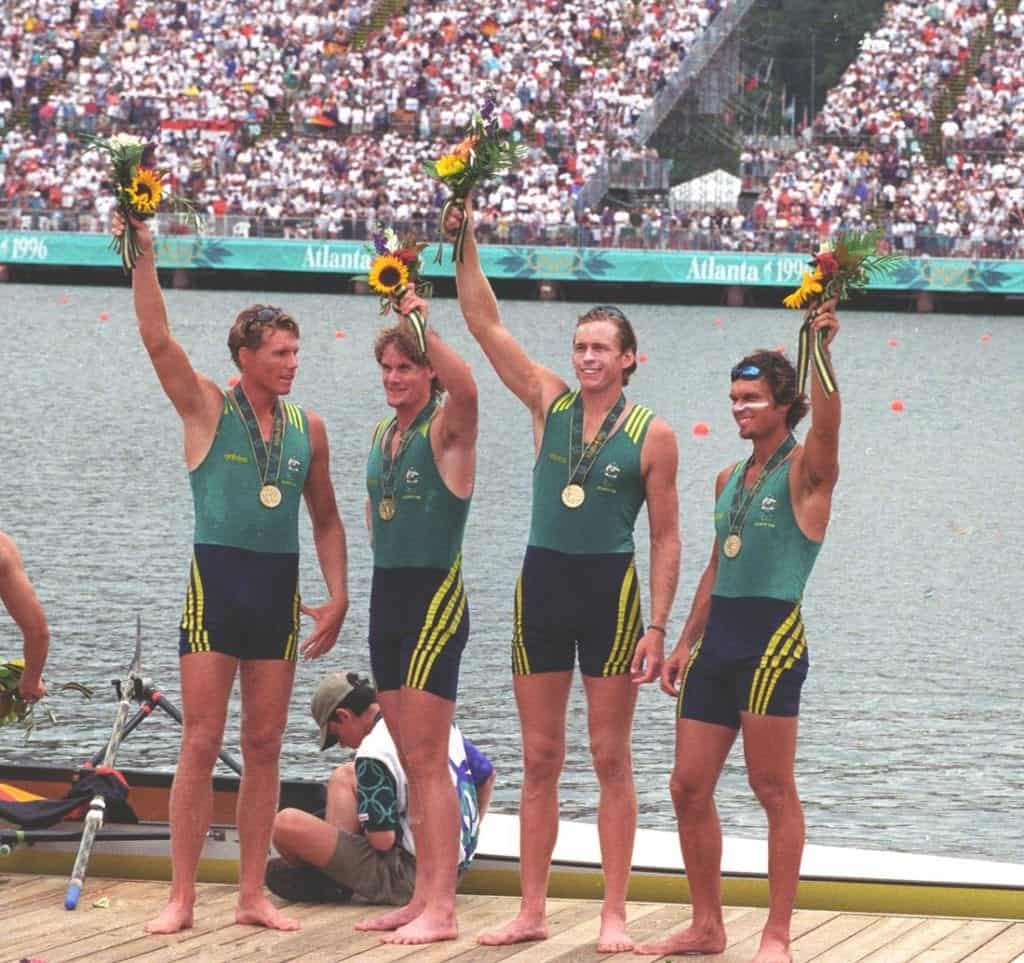By Bo Hanson – 4x Olympian, Coaching Consultant & Director of Athlete Assessments
Recently I had the time and pleasure to watch the 2013 movie Rush, directed by Ron Howard and starring Chris Hemsworth and Daniel Brühl. Rush, is based on the true story of the rivalry between Formula 1 Racers James Hunt and Niki Lauda in the 1970’s and focuses on their 1976 World Championship campaign. Personally, I found this movie to be one of the best I have ever seen as it describes each competitors rise from their privileged early life, to their family’s lack of acknowledgement and support for their Formula 1 dreams.
Ultimately each man strives through pure determination and an unwavering belief in themselves to eventually find a way into a Formula 1 team and the successes and massive hardships that follow. The movie provides such a wonderful insight into two of the greatest Formula 1 drivers who were similar in certain ways, but incredibly different in others. I found the movie to inspire me to write this article and to look at the two drivers from a DISC perspective. Where their profiles were similar, and where they are very different.Hopefully you also find this a unique way to learn about two DISC Profiles and enjoy a great sports movie. (Before we start, you might like to get a brief background and understanding of DISC theory as it is discussed in the rest of this article.)
 Chris Hemsworth (L) as James Hunt and Daniel Brühl (R) as Niki Lauda in Rush
Chris Hemsworth (L) as James Hunt and Daniel Brühl (R) as Niki Lauda in Rush
James Hunt – Dominance, Influence Profile
James Hunt was born on August 29, 1947, to the successful London stockbroker Wallis Hunt and his wife Sue. As he grew, he developed a determined, spirited and competitive behavioral style that would eventually gain him recognition as “Hunt the Shunt” during his professional race car driving career. He was a driver who lived on the edge of survival, pushing his car to the limit. He would take advantage of the slightest opportunity to find a gap and never hesitated to punch his way through it. By the end of the first scenes, it is obvious James Hunt’s DISC Profile is a Dominance, Influence (DI) Style. He is very high in D (at least 90) and also very high in I (slightly lower than his D). The movie provides a great insight into how this profile operates, what makes this profile great and what can be this profiles biggest limitations.
When Hunt was 18, he discovered his passion for racing. Despite his family being unsupportive, Hunt still pursed his dreams. This gives us the first insight into the Dominant (D) Style. They are unwavering in their pursuit of their goals, and if that means they need to work without family support, then so be it. If Hunt had a higher level of Steady (S) style, he would not have gone without the support of his parents. For a D, relationships are not as important as achieving their goals.
Hunt formed a partnership with the aristocrat, Alexander Hesketh, becoming part of a group known as the Hesketh Racing team. The team was eccentric to say the least, although Hunt fit in well, as he was not interested in established protocol, rules and structures that the more famous teams comply with. This gives us the belief that his level of Conscientious (C) style is very low. Throughout his career, Hunt became as famous for his extravagance and playboy reputation as his racing records. He surrounds himself with people, women and parties. He lives his life in the present, often too flamboyantly and spontaneously for his own good. This is typical of a High Influencing “I” style.
If we were to plot James Hunt’s profile it would look like the graph below. If you’re wondering if his Natural Style is different to his Adapting, I would suggest they are identical and what you see on the track is what you see off the track. In fact, it is a great example of how one can race according to their own style. When you see the movie, take a moment to imagine James Hunt racing any other way. It is also a great example of how your greatest strength can be your biggest limitation as James only luckily gets recruited by McLaren Racing at the last moment due to his reputation preceding him and McLaren being wary of this.
Niki Lauda – Dominance, Conscientious Profile
While James Hunt was beginning his racing career, Niki Lauda was also building a name for himself as a tough, calculating and uncompromising style of racer. He too was born into a family which associated itself with politicians, financiers and other business people. The expectation was Niki would do the same, and in a great scene in the movie he confronts his father about his future as a racing car driver only to be left unsupported. Niki then tells his father he will make his own name for himself on the front pages of the paper for being a World Champion. So determined was Lauda to enter Formula 1, he takes out a bank loan and buys his way onto a team and goes on to completely rework the race car making it lighter, better balanced and ultimately, faster. Those mechanics who did the work reported directly to Niki and through his contract Niki eventually gets paid for his driving.
This series of behaviors show Niki’s high Dominant (D) style through his complete focus on being a Formula 1 driver and in a similar way to James, he forgoes pleasing his family to pursue his dreams. Niki, though is entirely different to James in his style. Where James is an extroverted high I, Niki is a loner, preferring to do things individually and focus on the tasks he need to complete to be the best he can be. Niki is also very detail focused suggesting his high Conscientious Style. In fact, Niki earns the name, “the Computer” due to his precise, calculated risk and controlled style in which he drives. He is a perfectionist and technically there may never have been a better driver of this style. In 1974, he began to work for Enzo Ferrari, who hadn’t had a champion since 1964. It paid off when Lauda became a World Champion for Ferrari, earning Formula 1 victories in countries such as Spain and Holland.
This is what I believe Niki Lauda’s DISC Style would look like. And once again, I think his natural and adapting styles would be the same.
The Interaction of the Niki and James
The movie culminates in the 1976 Season, where both drivers have fast cars and ambitions to win the Championship. Without going into detail about the events, that season once again showcases the two drivers’ similarities and differences as they compete on their terms and become friends in a very respectful way, where each sees the greatness in the other. They value each other’s different approaches. In a remarkable scene at the German Grand Prix, Niki calls a driver’s meeting to discuss conditions which to him are unsafe.
Niki states he is willing to risk his life up to the 20% mark, but one percentage point more is unacceptable. He is trying to influence the other drivers to also say it is unsafe (which it is due to massive rainfall) but is baited by James and others, who say Niki is just trying to ensure there is one less race for the other drivers to catch his points tally for the season and win the Championship. When baited, Niki responds with his High Dominance style and tells the other drivers how much better a driver he is, that he could beat them all, and that he had the race record on the track to prove it. The other drivers had won the meeting at that point, as they retaliated and suggested that they race so Niki could, in fact, prove he was better. In a telling moment after the driver’s meeting, James pulls Niki aside and tells him how having friends and being friendly to others can help you. James used his relationships with the other drivers to achieve his desire to race that day.
As history has it, Niki suffered a horrific crash and almost burnt to death inside the car he could not escape from. Eventually after a minute inside the car whilst on fire, he is pulled free by a fellow driver and taken to hospital. At this point the movie demonstrates Niki’s extraordinary recovery, driven by his high Dominance, to once again race and be a Champion. Niki shows his high Dominance determination and goal focus, as despite his badly burnt lungs, broken bones and burns on his head and wrists, just six weeks after the crash, Lauda races again and finishes in fourth place.
At the final race of the 1976 Season in Japan, the race track was once again rainy, slippery and dangerous and Niki makes the decision to retire early after only four laps. Niki had enough points to let James fight for a top three finish, and if James could not achieve this result, Niki would retain the Championship. James finishes in third position after throwing everything into the race and chancing every turn. James raced with complete abandon, uncaring of the consequences. With his third place finish, James won the 1976 World Championship with one of the most extraordinary drives in the history of the sport. James openly admits to Niki in a later scene, that he was prepared to die to win that day. To Niki, that is not what winning is about. Too much risk. This shows the difference in the two driver’s level of C. Niki would weigh up of every detail of risk. Whereas James would not think about risk at all, and just drove without structure, determined to win whatever way he could.
For me, the movie as a wonderful exposition of two talented drivers. They were the best of the best, yet had very different approaches. There is a final scene in an aircraft hangar where Niki is inspecting his private jet, and talks to James who has flown in for a party on a chartered jet with his entourage. Niki talks about how James should learn to fly, as it teaches discipline, process and precision. James replies that he knew Niki would not be flying because of the spirituality or beauty of the experience. This once again contrasts the complete difference between the two people. By the end of this scene, Niki is encouraging James to start back at “work” by testing his new cars as Niki has already been doing. James replies that he has not worked as hard as he has to not party and enjoy it. To Niki, it is all about the work itself, to James it is the means to the end.
Niki is alive today. James died at 45.
I hope you have the opportunity to view this movie and appreciate it as a great movie and enjoy it for that. I also hope you see the link to DISC and the observation of two very different DISC Styles in action and how they both created massive success.
If you enjoyed this article you may also enjoy other interesting applications of DISC including How DISC is like the Hogwarts Houses (Harry Potter). There are also many valuable articles in our section on DISC Application and Theory.
At Athlete Assessments, we’re here to provide you with excellence in service and to help you be your best. If there is anything we can assist you with, please Contact Us.





